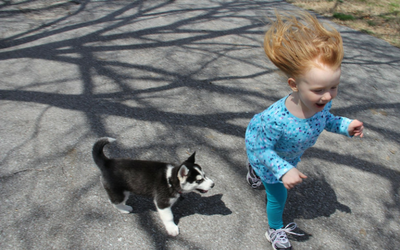
Bringing home a new puppy is such an exciting, joy-filled time! With a puppy comes a lot of work, but the time and effort that a family puts in during the early weeks of the puppy’s life will pay off with a lifetime of good behavior.
There is a critical period for socialization in puppies beginning around 2-3 weeks of age and lasting until 14-16 weeks of age. In order to develop healthy relationships with other dogs, puppies should remain with their mother and littermates until 7-8 weeks of age depending on the breeder. During the period from when the puppy is placed in a home (at around 7-8 weeks of age) to when the puppy is 14-16 weeks of age, puppy owners are encouraged to expose their puppy to other animals, people, and “strange and new” situations.
A recent study has shown that almost 1/3 of puppies receive only minimal exposure to people and dogs during the critical socialization period. The study also found that puppies that attended puppy classes had exposure to a greater number of other dogs and people during the critical period than puppies that did not attend puppy classes.
How to socialize your puppy!
Make an effort to expose your puppy to situations that he would not regularly be exposed to. For example, if there are no children in your home, try to arrange “play-dates” with children. If you live in the country where exposure to heavy traffic of cars and trucks might be limited, take some trips to the city and walk along busy streets. If you live in the city but have family or friends that live on a farm, take your puppy for a visit so he can be exposed to different farm animals and noisy farm equipment.
Be sure your puppy is exposed to car rides, elevators, and stairs. Likewise, expose your puppy to the sounds of airplanes overhead, trains passing by, lawn mowers, hairdryers, vacuum cleaners, and the radio – sounds that we take for granted, but are new to a puppy.
Be certain your puppy meets a wide variety of people of all ages, races, appearances, and of both sexes. Consider taking your puppy to a retirement home where he can meet elderly people using canes, walkers, or wheelchairs. Expose your puppy to people wearing different types of clothing – you’d be amazed at how fearful a dog can be of people wearing hooded sweatshirts or winter coats!
To help your puppy in these situations, provide rewards each time he is exposed to a new person, noise, or location. Have new “friends” offer a treat and be sure to give lots of verbal praise to your puppy. This helps teach your puppy to look forward to meeting people. Once your puppy has learned to sit, be sure to have his new friends ask for a “sit” before giving the treat.
If your puppy is fearful of these new situations, slow down and try again later rather than forcing him into a situation where he is fearful. Return to the situation and provide lots of encouraging words (and treats!) to help your puppy have a positive experience.
Enrolling your puppy in puppy socialization classes or obedience classes is a great way to help your puppy get exposure to people, other dogs, different noises, and car rides. Ask your veterinarian about puppy socialization and obedience classes in your area.
